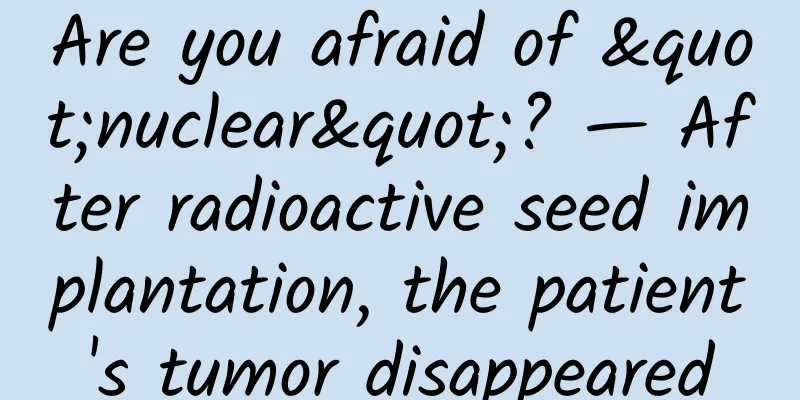Are you afraid of "nuclear"? — After radioactive seed implantation, the patient's tumor disappeared

|
Lung cancer is the most common cancer in the world, with the highest incidence and mortality rates. With the rapid development of medical technology, the treatment of lung cancer is becoming more and more abundant. Even the radioactive iodine-125 particles that people have always been afraid of can be used to treat cancer. 71-year-old Mr. Wang is a veteran. He was diagnosed with right lung cancer in the hospital because of coughing and coughing up blood. After hospitalization, Mr. Wang completed the relevant preoperative examinations as quickly as possible and underwent radical resection of right lung cancer. The operation recovered smoothly. Unfortunately, the tumor recurred again three years later. Compared with three years ago, Mr. Wang's health was not as good as before. In addition, he had severe pleural adhesion after the operation. It would be too difficult to have another operation. Mr. Wang's family also visited the best hospitals in the country and finally decided to carry out systemic chemotherapy plus local radiotherapy. However, the side effects of chemotherapy made Mr. Wang, who was already in poor health, even worse. He could not have surgery and could not tolerate chemotherapy, which worried Mr. Wang's family. When his family was at a loss, the doctor introduced a new treatment method to the family - radioactive particle implantation. When Mr. Wang's family heard that radioactive substances were being put into the human body, they were strongly opposed to it and even had great distrust of doctors. After we explained it again and again, and they searched for relevant literature on their own, they finally decided to give it a try. You don't know until you try it, and you will be shocked when you try it. Every time we checked Mr. Wang's tumor was shrinking, and finally, six months after the particle implantation, the tumor miraculously disappeared. What exactly are radioactive particles? In fact, the history of using radioactive substances to treat tumors began after the Curies discovered the radioactive nuclide radium in 1898. The radioactive particles used by Mr. Wang are iodine-125 particles. Doctors implant micro-radioactive source iodine-125 particles into the tumor or the tissue invaded by the tumor. The iodine-125 source continuously emits low-energy gamma rays to kill tumor cells or inhibit them. Are radioactive particles safe? Are they harmful to the human body? The international standard unit for the radiation dose people receive is the Sievert (sv), which quantifies the amount of radiation the human body receives. The larger the number, the greater the radiation dose received by the human body. If a normal person watches TV for one hour a day, the radiation damage he/she will receive in a year is about 10 microsieverts. The average annual radiation exposure of a normal person is 2000 microsieverts. The radiation emitted by radioactive particles is shown in the figure below: As can be seen from the above figure, the farther away from the radiation source, the less radiation you receive. Even if you are exposed to radioactive particles at a distance of 2 meters for a year, the cumulative radiation is only 1100 microsieverts, which is only half of the average annual radiation exposure of a normal person! So overall, radioactive iodine 125 particles are still very safe. What cancers are suitable for iodine-125 particle implantation? 125I radioactive particle implantation has developed rapidly in the field of malignant tumor treatment and is widely used in the treatment of various recurrent and metastatic malignant tumors, such as meningioma and brain metastasis, nasopharyngeal and oral cancer, cervical metastasis, lung cancer (primary or metastatic), lymphoma, breast cancer, esophageal cancer, mediastinal malignant tumors, liver cancer, bile duct cancer, pancreatic cancer, advanced gastrointestinal cancer, local bone metastasis of malignant tumors, etc. How to implant iodine-125 particles into a tumor? Under the guidance of CT, radioactive particles are implanted into the tumor by percutaneous puncture (using a puncture needle to implant the particles into the tumor), or surgically implant iodine-125 particles into the tumor or into tissues that may be invaded by the tumor, or into lymph nodes where the tumor has metastasized. The most commonly used method is percutaneous lung puncture, which is less damaging and less painful, and is currently the main method. What are the indications for iodine-125 radioactive particle therapy? 1. Untreated primary cancers such as prostate cancer and advanced laryngeal cancer 2. Patients whose tumors are difficult to completely remove, such as mid- to late-stage pancreatic cancer 3. Recurrent or metastatic cancer with isolated lesions (such as Mr. Wang mentioned above) 4. Residual cancer lesions caused by dose or tissue tolerance after external radiotherapy Summary: Iodine-125 seed implantation is an effective technique for comprehensive treatment of malignant tumors and a type of close-range radiotherapy. The radioactivity of radioactive particles is extremely low and does no obvious harm to the human body. Radioactive particle implantation can be used for patients who cannot tolerate surgery or have advanced localized metastatic lesions. Follow Dr. Lion to learn more about health knowledge |
<<: Hepatitis C Virus - "A Future Without Hepatitis"
>>: What does the world's largest mushroom look like? Which mushrooms under pine trees are edible?
Recommend
Normal range of progesterone and hcg values at 45 days of pregnancy
Progesterone is a type of pregnancy hormone secre...
Endometrial thickness 4mm is normal
The uterus is a reproductive organ unique to wome...
How to take care of yourself during menopause
Female friends should take care of their bodies d...
A little pain on the left and right sides of the lower abdomen
It is a common symptom for women to feel a little...
What causes menstrual headaches?
During the days of monthly bleeding in women, not...
What is the cause of leucorrhea with blood before menstruation?
As women, we have to face the situation of bloody...
Can I drink ginger and sugar water if I have uterine fibroids?
Uterine fibroids are a relatively common disease ...
Good news! The switch to burn calories has been found! Eat as much as you want and not gain weight?
Scientists have found a switch that controls calo...
6 secrets to make women wear high heels both comfortable and elegant
Of course, these are not ordinary flat shoes, can...
Is it normal to bleed after sleeping together?
Everyone knows that when a man and a woman have s...
Why is there pain on both sides of the lower abdomen?
There is bloating and pain on both sides of the l...
What to do if you have breast pain and lumps during weaning
With the mother's efforts, the baby can easil...
How to treat uterine fibroids in the early stages?
Uterine fibroids are one of the diseases that fem...
Will menstruation make you taller?
The average age of menarche for girls is 13 years...
What is the ending of Jia Baoyu? A brief introduction to the life of Jia Baoyu in Dream of the Red Chamber
Jia Baoyu was loved by his mother since he was yo...









